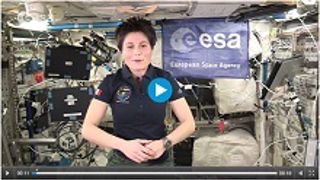
New Classroom Demonstration Video featuring ESA Astronaut Samantha Cristoforetti
- 10th Jun 2015
- "When is a moon a moon?" That was the starting question behind a video demonstration put together by the National Space Academy and the European Space Agency (ESA).
One method for identifying a moon is observing its orbital path around another object, usually a planet, as it, and they, travel together around the Sun. The point at which two objects orbit around each other is known as the barycentre: this is the centre of mass, or balance point, for the two objects. In the case of a large (massive) planet and small moon system, such as our own Earth and Moon, the barycentre exists within the planet itself.
The video demonstration, by ESA Astronaut Samantha Cristoforetti, on board the International Space Station (ISS) uses the station's microgravity environment to demonstrate a barycentric system and how it is affected by the mass of the two objects.
Despite being an ideal environment for this demonstration, putting together the experiment on the ISS was not without its own constraints, as Samantha - who has been living on board for the last six months and will return to Earth on the 11 June 2015 - and the National Space Academy, who scripted the video, were both very well aware that only equipment already aboard the ISS could be used. At first, rolled up balls of tape were suggested as an analogue for the moon and planet system; however the stickiness of the tape proved to be too much of a problem and was rejected. A solution presented itself with the use of two baseballs (apparently not a rarity on any orbiting space platform) which did the trick, as you can see in the video.
Andy McMurray – Head of Teaching and Learning, and lead scriptwriter on the video, who was asked to contribute to this project in his first few months of working for the National Space Academy, said:
"The topics covered in the video, which include gravitational attraction, free-fall and barycentre, are all included in schools physics curricula. This video can be a valuable and lasting teaching resource for teachers across Europe"
For more National Space Academy videos, including a classroom demonstration by Anu Ojha, have a look at these links:
